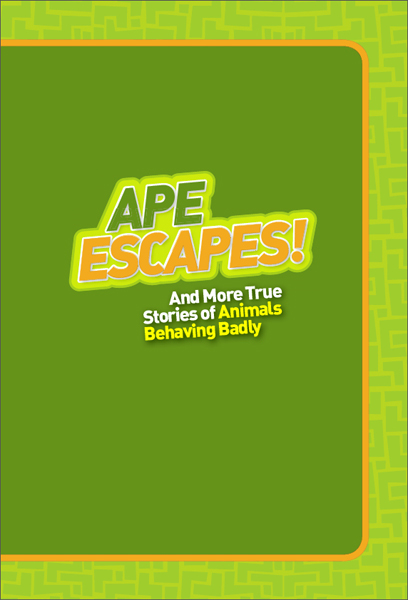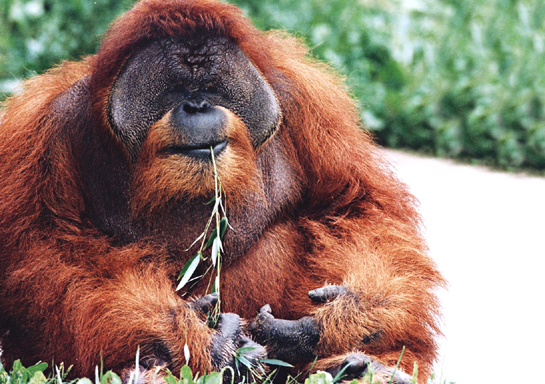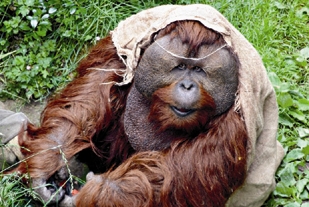
National Geographic Kids Chapters: Ape Escapes: and More True Stories of Animals Behaving Badly


Copyright © 2012 National Geographic Society
All rights reserved. Reproduction of the whole or any part of the contents without written permission from the publisher is prohibited.
Published by the National Geographic Society
John M. Fahey, Jr., Chairman of the Board and Chief Executive Officer
Timothy T. Kelly, President
Declan Moore, Executive Vice President; President, Publishing and Digital Media
Melina Gerosa Bellows, Executive Vice President; Chief Creative Officer, Books, Kids, and Family
Prepared by the Book Division
Hector Sierra, Senior Vice President and General Manager
Nancy Laties Feresten, Senior Vice President, Editor in Chief, Children’s Books
Jonathan Halling, Design Director, Books and Children’s Publishing
Jay Sumner, Director of Photography, Children’s Publishing
Jennifer Emmett, Editorial Director, Children’s Books
Eva Absher-Schantz, Managing Art Director, Children’s Books
Carl Mehler, Director of Maps
R. Gary Colbert, Production Director
Jennifer A. Thornton, Director of Managing Editorial
Staff for This Book
Becky Baines, Project Editor
Lisa Jewell, Illustrations Editor
Eva Absher, Art Director
Ruthie Thompson, Designer
Grace Hill, Associate Managing Editor
Joan Gossett, Production Editor
Lewis R. Bassford, Production Manager
Susan Borke, Legal and Business Affairs
Kate Olesin, Assistant Editor
Kathryn Robbins, Design Production Assistant
Hillary Moloney, Illustrations Assistant
Manufacturing and Quality Management
Christopher A. Liedel, Chief Financial Officer
Phillip L. Schlosser, Senior Vice President
Chris Brown, Vice President
George Bounelis, Vice President, Production Services
Nicole Elliott, Manager
Rachel Faulise, Manager
Robert L. Barr, Manager

For more information, please call
1-800-NGS LINE (647-5463) or
write to the following address:
National Geographic Society
1145 17th Street N.W.
Washington, D.C. 20036-4688 U.S.A.
Visit us online at nationalgeographic.com/books
For librarians and teachers: ngchildrensbooks.org
More for kids from National Geographic:
kids.nationalgeographic.com
For rights or permissions inquiries, please contact National Geographic Books
Subsidiary Rights: ngbookrights@ngs.org
eISBN: 978-1-4263-0957-1
v3.1
Version: 2017-07-05
CONTENTS
Cover
Title Page
Copyright
FU MANCHU: Ape Escapes!
Chapter 1: A Scamp Is Born
Chapter 2: Hero Prankster
Chapter 3: Wise Guy Ape
PEGGY: The Mischievous Pup
Chapter 1: Bad Puppy
Chapter 2: Emergency!
Chapter 3: Good Dog
OLIVIA: The Cat Burglar
Chapter 1: Wanted!
Chapter 2: Stop, Thief!
Chapter 3: “Stolen” Treasure
DON’T MISS!
Chapter 1: Call For Help
More Information
Dedication
Credits
Acknowledgments
FU MANCHU: APE ESCAPES!

Fu as a 250-pound (114 kg) “pasha.” A pasha is a full-grown male with cheek pads. (photo credit p1.1)

In the wild, baby orangutans like this one stay with their moms eight years or more. (photo credit p1.2)
Chapter 1 A SCAMP IS BORN
July 1965, Omaha, Nebraska
A young orangutan peers out of his cage at the Henry Doorly Zoo. No humans are in sight. The coast is clear.
He sticks his long fingers through the chain-link fence. He bends back one corner. He pulls. ZZIIIIP! The stiff metal fencing unravels like a hand-knit scarf.
Some time later, veterinarian Lee Simmons arrives at work. He rounds a bend in the path and yikes! Dr. Simmons stops in his tracks. It couldn’t be, but it is. A shaggy, red-haired ape sits up in a tree. How did he get loose?
The ape is about six years old, tailless, and weighs 100 pounds (45 kg). He has a mustache and beard like a famous movie character. For that reason he is called Fu Manchu. Fu’s arms are super strong and longer than most fourth graders are tall. In a wrestling match against a man, the orangutan would win.
The ape doesn’t move or make a sound. But Dr. Simmons sees a twinkle in his eyes. The vet can’t help but wonder if Fu knew what he was doing. It’s like he’s been sitting there just waiting for me.
Fu climbs down. The sun sparkles on his red hair as he scrambles back to his cage. Dr. Simmons follows, shaking his head. What a crazy ape! He locks Fu inside. He calls someone to fix the fence and then goes about his normal business. And Fu goes about his—dreaming up more hijinks to come.
Fu was born in a rain forest on the Indonesian island of Sumatra (sounds like SUE-MAH-TRA). Like most baby orangutans, Fu probably never knew his father. Orangutan mothers care for their helpless babies. Fu’s mother nursed him. She held him and snuggled him. Every night she built them a nest high in the treetops.
These sleeping nests were the size of bathtubs. Fu’s mother made them by twisting leafy branches together. Each fresh, new nest must have felt as comfy to Fu as clean bedsheets do to you.

Usually Fu and his mom stayed dry in their cozy bed in the sky. At other times thunder boomed. Rain fell in sheets. Then the apes huddled together and turned giant leaves into umbrellas.
During the day, Fu often rode on his mother’s back. He clutched her hair as they swung through the trees looking for durian (sounds like DUR-EE-ANN) fruits. Durian fruits stink like sweaty gym socks. But orangutans go ape for the smelly stuff.
The problem is durian fruits don’t all ripen at the same time, and the trees are scattered. To find them, orangutans must keep a map of the forest inside their heads. For Fu’s mother it must have been like memorizing a school bus route with hundreds of stops.
Finding water was easier. It collects in hollow tree trunks after a rain. Fu might have gotten a drink by scooping water out with a folded leaf. Or maybe he chewed leaves into a sort of sponge. Then he sopped up water and dripped it into his mouth. Either way, Fu used leaves as tools.
Long ago, Indonesian people dubbed these clever apes “orangutans.” In their language the word orang means “person” and utan means “forest.” Together you get “person of the forest.”

One day Fu and his mother heard strange sounds in the swamp. Hunters had entered the jungle. They carried axes and homemade nets on their backs. Rivers of sweat ran down the men’s bare chests. Armies of insects buzzed in their faces. But nothing stopped them. The men were animal collectors. They feed their families by catching and selling wild animals. A baby orangutan will get them a lot of money.
Did Fu’s mother know they wanted her baby? Probably not, but she sensed danger. She swung from limb to limb, snapping off branches. She threw the branches down on the hunters.

(photo credit 1.1)
Orangutans and Tools
Orangutans are the smartest of all the great apes. They learn new things quickly. Because of this, people have spent years studying orangutans and learning more about them. Orangutans have been seen in the wild and in zoos using tools to scratch themselves; cover themselves from the rain; collect water, honey, or bugs for food; swat stinging insects; and spear fish in the water.
The animal collectors looked up. The mother ape looked like a tiny black doll hanging against the blue sky. Was she holding a baby?
The hunters had a traditional way of catching orangutans. They didn’t try to climb up after them. Not at first. That might have spooked the ape into escaping through the treetops. Instead, the animal collectors formed a circle. They pulled out their axes and hacked away at tree trunks.
The ground shook as a tall tree crashed to the forest floor. Then a second one, and a third. The trees were so close together that each one that fell knocked down another. CHOP! CHOP! The men worked their way to the last tree—the one holding the apes.
“Pzz squee.” Fu’s mother squeaked and ran, looking for a way to escape. Seeing none, she moved far out on a limb.
A man climbed way, way up the smooth trunk. He broke off a leafy branch and shook it at her.
Fu’s mother probably did what most orangutans do when cornered by hunters. She smacked her lips. Her black eyes shone with fear. With one man in the tree and more below, she first scrambled up and then down. Up and then down.
Suddenly the scared ape leaped to the ground. With her baby hugging her belly, she ran for her life. But the men ran faster.
The boss hunter yelled. He ordered his men to throw their nets.
SWOOSH! The apes were trapped!

Fu, always the practical joker, loved performing for happy, smiling zoo visitors. (photo credit 1.2)
Chapter 2 HERO PRANKSTER
The animal collectors have gotten what they came for. They carry Fu out of the jungle and ship him to Singapore. They put him up for sale in the marketplace. Except for his fur, the little red ape looks much like a human baby. An American man has come to buy animals for a zoo in Louisiana. He likes the look of Fu. The American has already spent a lot of money on rare parrots, monkeys, pythons, and crocodiles. Now he buys Fu.
Fu spends three years in Louisiana. Then he is sent to Omaha, Nebraska.
In the wild, Fu swung from branches and hung from vines. Thumbs on his feet as well as his hands helped him hang on. Sometimes he went two weeks without touching the ground.
Life is different in a zoo. Soon after Fu arrives in Omaha, the zookeepers build a large, modern Great Ape House. But only a few trees grow in the Ape House yard. They are nothing like the giant trees that grow packed together in the rain forest. Fu can’t build a sleeping nest in them. There is no tangled jungle for him to learn his way around. But the most important difference is food. Here a zookeeper brings him supper in a bowl. Fu does not need to find his own meals. He does not need to memorize 1,000 different kinds of plants like his mom did.
Like a bored kid in school, Fu turns his mind to other things. When a tree dies in his yard, Fu pulls it apart. He gathers up two chunks of wood and sets them against the building. They make a ramp that he can climb.
“There’s an ape on the roof!” shouts a zoo visitor.
Dr. Simmons rushes to the scene. “Fu,” he orders, hands on his hips. “Come down from there.”
Fu ignores him. The naughty ape scrambles across the roof and wraps his hairy arms around the chimney. CAARACK! He tears it off the roof and flings it over the edge!
That does it. Zookeeper Jerry Stones has had enough. Maybe he can help the bored ape stay out of trouble. He will give Fu something to swing on.

Jerry goes inside the orangutan’s cage and hangs a chain from one wall to another. Fu sits quietly in a corner and pretends not to notice, but the tricky ape is secretly watching the whole time.
Looks good, Jerry thinks, when he finishes. He packs up his tools and leaves, banging the door behind him.
The next morning Jerry returns to admire his work. But when he enters the ape house, he just stands there in shock! The steel chain he had so carefully hung lies in a pile on the floor. Fu stands beside it—holding the screws in his fist.
Grumbling, Jerry rehangs the chain. Then he pulls out his hammer. WHAM! He flattens the end of each screw.
Not even Fu can take them out now, he thinks.
A month goes by. Jerry forgets the mischief. He goes to the Ape House to give Fu some monkey biscuits and … gasp! The heavy chain lies on the floor like a broken necklace. How on earth?
Fu was sneaky. He must have spent weeks turning those screws when no one was looking.
“Doggone it, Fueey,” mutters Jerry. He grabs a ladder and tools.
CLATTER! CLANK! BANG! Jerry hangs the chain for the third time.
Fu is naughty all right, but he is also kind. On another day Dr. Simmons and a second man are working together inside Fu’s cage. The floor is wet. The other man slips and sticks out his hand to catch himself. He accidentally touches the big picture window that separates Fu from zoo visitors.
ZAP!
An electric shock knocks the man across the room. He lands curled up on the floor.
Fu rushes to help. First, he looks over the shaken man for injuries. Then he straightens out the man’s finger. Finally, he leads him to the window.
The window is electrified to keep Fu from smudging the glass. But one little strip is safe to touch, and Fu knows it. The smart ape places the man’s finger there. It is like he is saying, “Next time, touch here. Then you won’t get hurt.”
Fu made zoo officials want more apes like him. But the Indonesian government passed a law protecting orangutans. Catching, killing, and selling them was illegal. That left one solution. They had to find Fu a girl orangutan.
Zookeepers put Fu and another orangutan named “Tondelayo” together. The two apes hit it off right away, but Tondelayo doesn’t like Jerry. She paces and her lips tighten whenever he enters their cage. He feels uneasy around her.
Конец ознакомительного фрагмента.
Текст предоставлен ООО «ЛитРес».
Прочитайте эту книгу целиком, купив полную легальную версию на ЛитРес.
Безопасно оплатить книгу можно банковской картой Visa, MasterCard, Maestro, со счета мобильного телефона, с платежного терминала, в салоне МТС или Связной, через PayPal, WebMoney, Яндекс.Деньги, QIWI Кошелек, бонусными картами или другим удобным Вам способом.
Вы ознакомились с фрагментом книги.
Для бесплатного чтения открыта только часть текста.
Приобретайте полный текст книги у нашего партнера:
Полная версия книги
